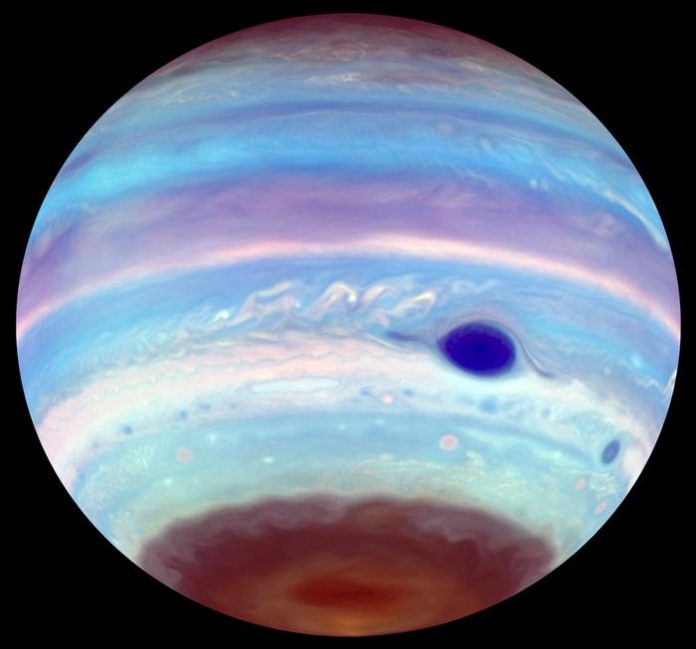
Astronomers have discovered mysterious, Earth-sized dark spots at Jupiter’s poles that appear and disappear unpredictably.
These spots, only visible in ultraviolet (UV) light, are embedded in a thick haze at the poles and seem to be linked to the planet’s strong magnetic field.
The discovery, made by researchers at the University of California, Berkeley, was recently published in Nature Astronomy.
While Jupiter’s iconic Great Red Spot has been studied for centuries, these UV dark spots at the north and south poles are less well-known.
Located just below the bright auroras—similar to Earth’s northern and southern lights—these spots absorb more UV light, making them stand out in images captured by NASA’s Hubble Space Telescope.
Between 2015 and 2022, a dark UV spot was found at the south pole in 75% of Hubble’s images. However, dark spots were much rarer at the north pole, appearing in only one out of eight images.
What causes these spots?
These polar spots hint at unusual activity within Jupiter’s magnetic field. Unlike Earth’s auroras, which occur in the upper atmosphere, these spots seem to be connected to deeper processes that stir up Jupiter’s atmosphere far below.
The research team, led by UC Berkeley undergraduate Troy Tsubota and astronomer Michael Wong, analyzed decades of Hubble images as part of NASA’s Outer Planet Atmospheres Legacy (OPAL) project. This program regularly observes Jupiter, Saturn, Uranus, and Neptune to track atmospheric changes over time.
“This is the first time MRI-like imaging has been used to connect Jupiter’s magnetic field to its polar haze,” Tsubota said. “We realized these Hubble images were like a gold mine for studying atmospheric dynamics.”
The team consulted experts in planetary atmospheres to understand what could be causing the dark spots. One idea, proposed by Tom Stallard from Northumbria University, is that the spots are formed by swirling vortexes in Jupiter’s atmosphere. These vortexes are created when friction occurs in two distant areas: the ionosphere (where charged particles spin rapidly) and a plasma sheet surrounding the planet, created by volcanic activity on Jupiter’s moon Io.
The vortexes weaken as they descend through the atmosphere but stir up thick haze, like a tornado kicking up dust. This haze is 50 times thicker than usual and forms dark spots that take about a month to appear and vanish within weeks.
This discovery offers valuable insight into how Jupiter’s atmospheric layers interact, something we don’t fully understand even on Earth. “Studying connections between atmospheric layers is crucial for understanding all planets, whether it’s Jupiter, Earth, or even exoplanets,” Wong explained.
The findings also reveal how processes within Jupiter’s magnetic field, its volcanic moon Io, and the surrounding plasma environment connect with the planet’s deep atmosphere. This provides a more complete picture of how giant planets like Jupiter function.
“This study helps us see Jupiter as a whole system,” Wong added. “It’s evidence of processes that connect everything from the planet’s core to its outermost layers.”
While the cause of the thick haze is still unclear, researchers believe the dark spots form from vortex dynamics rather than chemical reactions triggered by high-energy particles in the upper atmosphere. More observations and advanced imaging are needed to confirm this.
By continuing to study Jupiter’s polar spots, scientists hope to unlock more secrets about the solar system’s largest planet. These findings may also help us better understand atmospheric systems on other planets, including Earth.
Source: UC Berkeley.



